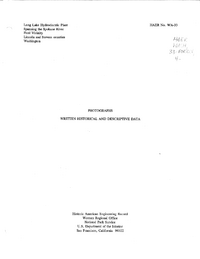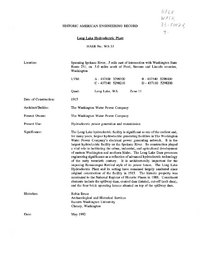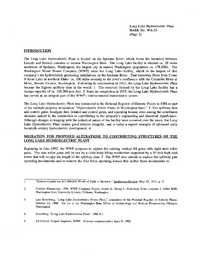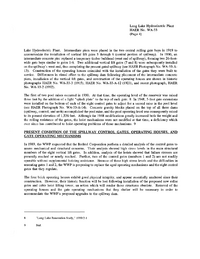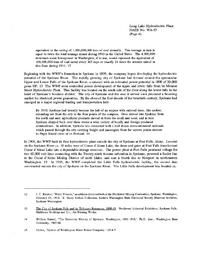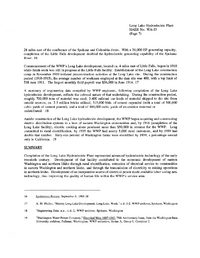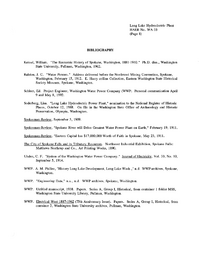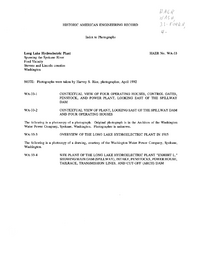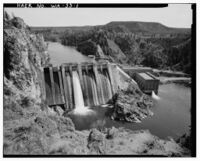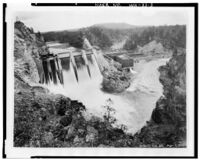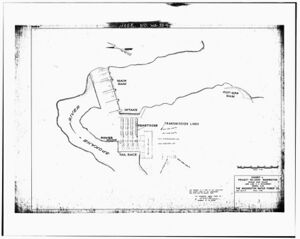Long Lake Dam Historic American Engineering Record WA-33
Long Lake Dam Historic American Engineering Record
This is a historic document which placed Long Lake dam in the Historic American Engineering Record WA-33. The format has been changed in two ways. First the two repositories, text and photographs, in the Library of Congress have been merged to give each other more context. Second, some liberty has been applied to the document to reorder the paper structure (especially continuation pages and some data field formatting). Footnotes have been converted to end notes. No data has been deleted and the originals are also accessible. Edit this document only to correct transcription and typographical errors.
The original document for the text form is here. The original document for the accompanying photographs is here.
Long Lake Hydroelectric Plant
HAER No. WA-33
Spanning the Spokane River
Ford Vicinity
Lincoln and Stevens counties
Washington
PHOTOGRAPHS
"""WRITTEN HISTORICAL AND DESCRIPTIVE DATA
Historic American Engineering Record
Western Regional Office
National Park Service
U.S. Department of the Interior
San Francisco, California 94102
HISTORIC AMERICAN ENGINEERING RECORD
Long Lake Hydroelectric Plant
HAER No. WA-33
| Location: | Spanning Spokane River, .5 mile east of intersection with Washington State Route 231, ca. 5.0 miles south of Ford, Stevens and Lincoln counties, Washington
UTM: A - 437100 5298320 B - 437340 5298400 C - 437340 5298210 D - 437110 5298200 Quad: Long Lake, WA Zone 11 |
| Date of Construction: | 1915 |
| Architect/Builder: | The Washington Water Power Company |
| Present Owner: | The Washington Water Power Company |
| Present Use: | Hydroelectric power generation and transmission |
| Significance: | The Long Lake hydroelectric facility is significant as one of the earliest and, for many years, largest hydroelectric generating facilities in The Washington Water Power Company’s electrical power generating network. It is the largest hydroelectric facility on the Spokane River. Its construction played a vital role in facilitating the urban, industrial, and agricultural development of eastern Washington and northern Idaho. The Long Lake Dam possesses engineering significance as a reflection of advanced hydroelectric technology of the early twentieth century. It is architecturally important for the imposing Romanesque Revival style of its power house. The Long Lake Hydroelectric Plant and its setting have remained largely unaltered since original construction of the facility in 1915. The historic property was nominated to the National Register of Historic Places in 1988. Constituent elements include the spillway dam, control dam (intake), cut-off (arch dam),and the four brick operating houses situated on top of the spillway dam. |
| Historian: | Robin Bruce Archaeological and Historical Services Eastern Washington University Cheney, Washington |
| Date: | May 1992 |
INTRODUCTION
The Long Lake Hydroelectric Plant is located on the Spokane River, which forms the boundary between Lincoln and Stevens counties in eastern Washington State. The Long Lake facility is situated ca. 28 miles northwest of Spokane, Washington, the largest city in eastern Washington (population ca. 178,000). The Washington Water Power Company (WWP) owns the Long Lake facility, which is the largest of that company’s six hydroelectric generating installations on the Spokane River. That waterway flows from Coeur d’Alene Lake in northern Idaho ca. 100 miles westerly to the river’s confluence with the Columbia River at Miles, Stevens County, Washington. Following its construction in 1915, the Long Lake Hydroelectric Plant became the highest spillway dam in the world.[1] The reservoir formed by the Long Lake facility has a storage capacity of ca. 105,000 acre feet.[2] Since its completion in 1915, the Long Lake Hydroelectric Plant has served as an integral part of the WWP’s interconnected transmission system.
The Long Lake Hydroelectric Plant was nominated to the National Register of Historic Places in 1988 as part of the multiple property nomination “Hydroelectric Power Plants in Washington State."[3] The spillway dam and control gates, headgate dam (intake) and control gates, and operating houses were among the constituent elements named in the nomination as contributing to the property’s engineering and historical significance. Although changes in keeping with the industrial nature of the facility have occurred over the years, the Long Lake Hydroelectric Plant retains good exterior integrity, and is today a superb example of advanced early twentieth century hydroelectric development.[4]
MIGRATION FOR PROPOSED ALTERATIONS TO CONTRIBUTING STRUCTURES OF THE LONG LAKE HYDROELECTRIC PLANT
Beginning in June 1992, the WWP proposes to replace the existing vertical lift gates with eight steel roller gates. The new roller gates will be run by a cable hoist lifting mechanism supported by a 35-foot-high steel tower that will occupy the length of the spillway dam.[5] The WWP also intends to replace the spillway gate operating mechanisms and to remove the four brick operating houses that shelter those mechanisms to accommodate the gate lifting tower. These elements are named as contributing structures in the NRHP nomination.[6] Removal of these structures will adversely affect character defining features of the historic property. This report has been prepared as mitigation for the WWP’s proposed undertaking on the spillway dam, control gates, operating houses, and operating mechanisms.
SITE DESCRIPTION AND LAYOUT
The Long Lake Hydroelectric Plant occupies one of the most spectacular sections of the Spokane River. Rising dramatically above the Long Lake facility, massive granite bluffs tower as high as 400 feet above the level of the spillway pool (see HAER Photograph No. WA-33-1). Directly below the spillway dam, the Spokane River makes a complete horseshoe bend and passes through a canyon whose vertical walls and impressive height provide an ideal location for a structure which, at the time of its construction, became the highest spillway dam in the world. The spillway dam (main dam) and control dam (or intake) roughly form an "L" shape, with the intake’s four penstocks extending from the base of the "L", through the back of the brick powerhouse, and directly into four turbine-generator units situated inside the powerhouse (see HAER Photograph No. WA-33-4 for a site plan of the facility). Located ca. 700 feet south of the powerhouse, the 100-foot-high cut-off (arch) dam fills a gulch, thus preventing outflow from the Long Lake Reservoir. Although the Long Lake Hydroelectric Plant is located less than thirty miles west of Spokane, a major metropolitan area, the site of the hydroelectric facility still conveys the sense of remoteness and grandeur that is evident both in early photographs of the installation (see HAER Photograph No. WA-33-3), and in descriptions of the facility at the time of its construction:
Twenty-nine miles northwest of this city [Spokane] the Spokane river shoots into a canyon the granite of which tower almost 400 feet above the foaming water. At a certain point the walls swerve sharply and here the water whirls as squarely as a current can around a rock promontory that runs up into a stony spire. Two boiling rapids in the bend drop the river still lower in its plunging flight from Lake Coeur d"Alene to the Columbia.
Every element of the scene expresses and impresses the sense of massive force and power-- power that for ages has run to waste.[7]
ALTERATIONS AND ADDITIONS
The most significant structural changes to the spillway dam occurred within the first fifteen years of the completion of the Long Lake Hydroelectric Plant (1915-1930). The addition of intermediate concrete piers constructed in the rolling gate bays created the most noticeable and dramatic new visual effects to the Long Lake Hydroelectric Plant. Intermediate piers were placed in the two central rolling gate bays in 1919 to accommodate the installation of vertical lift gates 3 through 6 (central portion of spillway). In 1930, an intermediate concrete pier replaced a temporary timber bulkhead (west end of spillway), forming two 26-foot- wide gate bays similar to gates 1-6. Two additional vertical lift gates (7 and 8) were subsequently installed on the spillway’s west end, thus completing the present gated spillway (see HAER Photograph No. WA-33-A- 13). Construction of the operating houses coincided with the installation of the gates they were built to service. Differences in visual effect to the spillway dam following placement of the intermediate concrete piers, installation of the vertical lift gates, and construction of the operating houses are shown in historic photographs HAER No. WA-33-3 (1915), HAER No. WA-33-A-12 (1923), and recent photograph, HAER No. WA-33-2 (1992).
The first of two pool raises occurred in 1930. At that time, the operating level of the reservoir was raised three feet by the addition of a light "splash plate" to the top of each gate.[8] In 1948, 5-foot gate extensions were installed on the bottom of each of the eight control gates to adjust for a second raise in the pool level (see HAER Photograph No. WA-33-A-14). Concrete gravity blocks placed on the top of all three dams (spillway, control, and arch) accomplished the pool raise, and the pool operating level was consequently raised to its present elevation of 1,536 feet. Although the 1948 modifications greatly increased both the weight and the rolling resistance of the gates, the hoist mechanisms were not modified at that time, a deficiency which ever since has contributed to hoist operating problems of those mechanisms.[9]
PRESENT CONDITION OF THE SPILLWAY CONTROL GATES, OPERATING HOUSES, AND GATE OPERATING MECHANISMS
In 1989, the WWP requested that the Bechtel Corporation perform a detailed analysis of the control gates to assess mechanical and structural concerns. Their analysis showed high stress levels in the main structural members of the eight vertical lift gates. In addition, analysis of the hoists showed that failure stresses are presently reached or nearly reached. Further, two of the control gates (numbers | and 2) are not readily operable without supplemental hoisting assistance. Because of these high stress levels and the difficulties in unseating gates 1 and 2, the WWP is proposing to replace the aged operating mechanisms and the eight control gates that they regulate.
The four brick operating houses exhibit good physical integrity, and appear essentially unaltered since their construction. However, their historic function will be lost following installation of the proposed new roller gates and cable hoist lifting tower, an action which will render those structures obsolete. Removal of the operating houses and the gate operating mechanisms that they shelter will be necessary in order to accommodate the WWP’s proposed upgrades to the spillway dam.
ENGINEERING SIGNIFICANCE OF THE CONTROL GATES, OPERATING HOUSES AND GATE OPERATING MECHANISMS
At the time of its construction in 1915, the Long Lake Hydroelectric Power Plant reflected advanced hydroelectric technology of the early twentieth century. Innovations represented by the facility included the use of rolling gates (the first application of that technology in the United States), the introduction of the 25,000 HP inward flow reaction-type Francis turbines (then the largest output capacity turbines in the world), and construction of the highest spillway dam in the world.[10]
HISTORICAL CONSTRUCTION COST OF THE LONG LAKE CONTROL GATES AND OPERATING HOUSES
| Description | Years | Amount |
|---|---|---|
| Control gates | 1915-1921 | 81,362.15 |
| Control gate operating houses | 1919-1923 | 2,769.15 |
| Control gate operating mechanisms | 1922-1924 | 1,045.36 |
| Control gates | 1930-1931 | 59,483.98 |
| Extend control gates and apron | 1949-1950 | 44,051.95 |
| Total | 188,712.59 |
WWP Accounting Department[11]
HISTORIC CONTEXT
Timing, public sentiment, and growing consumer demand contributed to the completion of the WWP’s Long Lake Hydroelectric Plant. By the first decade of the twentieth century, engineers understood and promoted the hydroelectric potential of Washington State, as the following excerpt from an address delivered before the Northwest Mining Convention in Spokane in 1912 indicates:
The State of Washington contains a greater amount of available water power than any other state in the Union. It totals 4,000,000 horsepower, of which less than 6 percent is developed. If the minimum water power of the United States were in use, it would be the equivalent to the saving of 1,000,000,000 tons of coal annually. This tonnage in turn is equal to twice the total tonnage mined during 1910 in the United States. The 4,000,000 minimum water horsepower in Washington, if in use, would represent the equivalent of 108,000,000 tons of coal saved every 365 days or exactly 24 times the amount mined in this State during 1911.[12]
Beginning with the WWP’s formation in Spokane in 1899, the company began developing the hydroelectric potential of the Spokane River. The rapidly growing city of Spokane had formed around the spectacular Upper and Lower Falls of the Spokane River, a cataract with an estimated power potential in 1890 of 30,000 gross HP.[13] The WWP soon controlled power development of the upper and lower falls from its Monroe Street Hydroelectric Plant. That facility was located on the south side of the river along the lower falls in the heart of Spokane’s business district. The city of Spokane and the area it served soon provided a booming market for electrical power generation. By the close of the first decade of the twentieth century, Spokane had emerged as a major regional trading and transportation hub:
By 1910, Spokane had literally become the hub of an empire with railroad lines, like spokes, extending out from the city to the four points of the compass. Ores moved into Spokane from the north and east; agricultural products moved in from the south and west; and in turn Spokane shipped back over these routes a wide variety of locally and foreign produced commodities. In addition, Spokane was connected with a half dozen transcontinental railroads which passed through the city carrying freight and passengers from far eastern points enroute to Puget Sound cities or to Portland.[14]
In 1906, the WWP built its first hydroelectric plant outside the city of Spokane at Post Falls, Idaho. Located on the Spokane River ca. 10 miles west of Coeur d’Alene Lake, the dams and gates at Post Falls transformed Coeur d’ Alene Lake into a dependable storage reservoir. The power plant at Post Falls produced voltage for two 60,000 volt lines connecting with the Twenty-ninth Avenue substation in Spokane, powered a feeder line to the Coeur d’Alene Mining District of north Idaho, and sent a fourth line to Newport in northeastern Washington.[15] In 1910, the WWP completed the Little Falls hydroelectric facility, the second dam constructed outside the city of Spokane on the Spokane River. The Little Falls development was located ca. 28 miles east of the confluence of the Spokane and Columbia rivers. With a 36,000 HP generating capacity, completion of the Little Falls development doubled the hydroelectric generating capability of the Spokane River.[16]
Commencement of the WWP’s Long Lake development, located ca. 4 miles east of Little Falls, began in 1910 while finish work was still in progress at the Little Falls facility. Establishment of the Long Lake construction camp in November 1910 initiated preconstruction activities at the Long Lake site. During the construction period (1910-1915), the average number of workmen employed at the dam site was 400, with a top limit of 538 men 1911. The largest monthly field payroll was $36,000 in June 1914.[17]
A summary of engineering data compiled by WWP engineers, following completion of the Long Lake hydroelectric development, reflects the colossal nature of that undertaking. During the construction period, roughly 700,000 tons of material was used, 3,400 railroad car loads of material shipped to the site from outside sources, ca. 2.5 million bricks utilized, 315,000 bbls. of cement expended (with a total of 300,000 cubic yards of cement poured), and a total of 460,000 cubic yards of excavation removed or redistributed.[18]
Amidst construction of the Long Lake hydroelectric development, the WWP began acquiring and constructing electric distribution systems in a host of eastern Washington communities and, by 1916 (completion of the Long Lake facility), electric cooking alone produced more than $50,000 in revenue for the WWP. Long committed to rural electrification, by 1919 the WWP had nearly 5,000 rural customers, and by 1939 had double that number. Sixty-one percent of Washington farms were electrified by 1939, a percentage second only to California.[19]
SUMMARY
Completion of the Long Lake Hydroelectric Plant represented advanced hydroelectric technology of the early twentieth century. Development of that facility contributed to the economic development of eastern Washington and northern Idaho through rural electrification, extension of electrical service to communities in eastern Washington and northern Idaho, and through the transmission of electricity to mining operations in northern Idaho. Development of an inexpensive source of electrical power made available labor saving new technology, thus improving the quality of human life within the WWP’s service area.
BIBLIOGRAPHY
Kensel, William. "The Economic History of Spokane, Washington, 1881-1910." Ph.D. diss., Washington State University, Pullman, Washington, 1962.
Ralston, J. C. "Water Powers." Address delivered before the Northwest Mining Convention, Spokane, Washington, February 15, 1912. E. Harry Collins Collection, Eastern Washington State Historical Society Museum, Spokane, Washington.
Schlect, Ed. Project Engineer, Washington Water Power Company (WWP. Personal communication April 9 and May 8, 1992.
Soderberg, Lisa. "Long Lake Hydroelectric Power Plant," nomination to the National Register of Historic Places, October 12, 1988. On file in the Washington State Office of Archaeology and Historic Preservation, Olympia, Washington.
Spokesman-Review, September 5, 1909.
Spokesman-Review, "Spokane River will Drive Greatest Water Power Plant on Earth," February 19, 1911.
Spokesman-Review, "Eastern Capital has $17,000,000 Worth of Faith in Spokane, May 23, 1911.
The City of Spokane Falls and its Tributary Resources. Northwest Industrial Exhibition, Spokane Falls: Matthews Northrup and Co., Art Printing Works, 1890.
Uhden, C. F. "System of the Washington Water Power Company." Journal of Electricity, Vol. 33, No. 10, September 5, 1914.
WWP. A. M. Philleo, "History Long Lake Development, Long Lake Wash.," n.d. WWP archives, Spokane, Washington.
WWP. "Engineering Data," n.a., n.d. WWP archives, Spokane, Washington.
WWP. Untitled manuscript, 1938. Papers. Series A, Group I, Historical, from container 1 folder MSS, Washington State University Library, Pullman, Washington.
WWP. Electrical West 1887-1962 (75th Anniversary Issue). Papers. Series A, Group I, Historical, from container 2, Washington State University archives, Pullman, Washington.
References
- ↑ “Eastern Capital has $17,000,000 Worth of Faith in Spokane," Spokesman-Review, May 23, 1911, p. 5.
- ↑ Untitled Manuscript, 1938, WWP Company Papers, Series A, Group 1, Historical, from container 1 folder MSS, Washington State University Library, Pullman, Washington
- ↑ Lisa Soderberg, "Long Lake Hydroelectric Power Plant," nomination to the National Register of Historic Places, October 12, 1988. On file in the Washington State Office of Archaeology and Historic Preservation, Olympia, Washington
- ↑ Soderberg, "Long Lake Hydroelectric Plant,” 1986:8:1
- ↑ Ed Schlect, Project Engineer, WWP. Personal communication April 9, 1992
- ↑ Soderberg, "Long Lake Hydroelectric Plant," 1988:7:2.
- ↑ “Spokane River will Drive Greatest Water Power Plant on Earth,": Spokesman-Review, February 19, 1911: 1.
- ↑ “Long Lake Renovation Study,” 1990:2-1
- ↑ Ibid.
- ↑ Soderberg, "Long Lake Hydroelectric Plant," 1988:8:1
- ↑ Historical Cost for Long Lake Spillgates and Control Houses,” WWP, 1992:n.p.
- ↑ J.C. Ralston, "Water Powers,” an address delivered before the Northwest Mining Convention, Spokane, Washington, February 15, 1912. E. Harry Collins Collection, Eastern Washington State Historical Society Museum Archives, Spokane Washington
- ↑ The City of Spokane Falls and its Tributary Resources, 1890:40. Northwest Industrial Exhibition, Spokane Falls, Matthews Northrup and Co., Art Printing Works.
- ↑ William Kensel, "The Economic History of Spokane, Washington, 1881-1910," Ph.D. diss., Washington State University, 1962:88.
- ↑ Uhden, "System of Washington Water Power Company,” 1914:5.
- ↑ Spokesman Review, September 5, 1909:10
- ↑ A. M. Philleo, "History Long Lake Development, Long Lake, Wash,” n.d.:1-2, WWP archives, Spokane, Washington 18 "Engineering Data, n.a., n.d.:2, WWP archives, Spokane, Washington
- ↑ "Engineering Data", n.a., n.d.:2, WWP archives, Spokane, Washington.
- ↑ "Washington Water Power Company," Electrical West 1887-1962, 75th Anniversary Issue, from the Washington State University archives, Pullman, Washington, WWP collection, Series A, Group I, Container 2.
HISTORIC AMERICAN ENGINEERING RECORD
Index to Photographs
Long Lake Hydroelectric Plant
HAER No. WA-33
Spanning the Spokane River
Ford Vicinity
Stevens and Lincoln counties
Washington
NOTE: Photographs were taken by Harvey S. Rice, photographer, April 1992
| WA-33-1 | Contextual view of four operating houses, control gates,
penstock, and power plant, looking east of the spillway dam. Photograph taken by Harvey S. Rice, photographer, April 1992. |
|
| WA-33-2 | Contextual view of plant, looking east of the spillway dam
and four operating houses. Photograph taken by Harvey S. Rice, photographer, April 1992. |
|
| WA-33-3 | Overview of the long lake hydroelectric plant in 1915.
This is a photocopy of a photograph. Original photograph is in the archives of the Washington Water Power company, Spokane, Washington. Photographer is unknown. |
|
| WA-33-4 | site plan of the long lake hydroelectric plant “exhibit l,"
showing main dam (spillway), intake, penstocks, power house, tailrace, transmission lines, and cut-off (arch) dam. This is a photocopy of a photograph. Original photograph is in the archives of the Washington Water Power company, Spokane, Washington. Photographer is unknown. |
